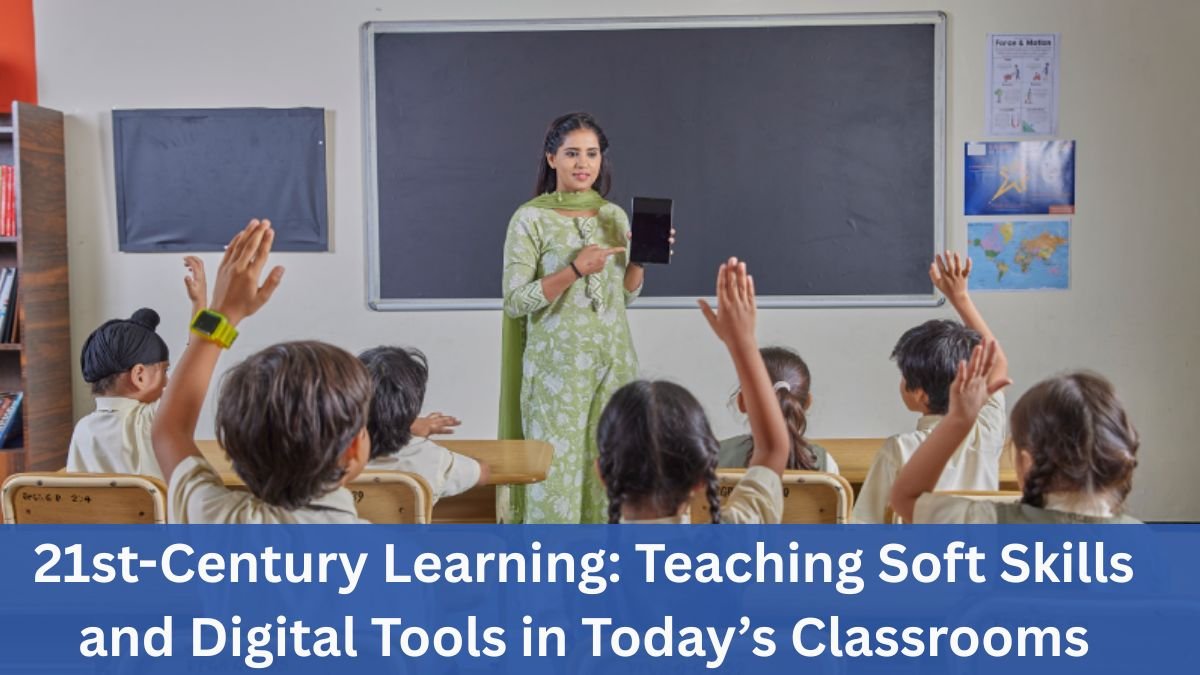The nature of education has completely changed in the 21st century. Earlier, education was limited to bookish knowledge, but now it has become a holistic development process, in which it is necessary to provide students not only subject knowledge but also to equip them with soft skills and digital literacy necessary to succeed in life.
Today’s classrooms are equipped with technology, teaching methods have become interactive and learner-centric, and teachers are no longer just “gyaan daata” (giver) but “facilitator”. In this article, we will discuss in detail how the integrated use of soft skills and digital tools in 21st century classrooms is preparing students for the future.
The changing landscape of 21st century education
Education is no longer limited to just passing exams and getting top marks. Today the world needs young people who can:
- work in a team,
- solve problems,
- understand and use digital technology,
- be socially and emotionally strong.
All this is not possible without soft skills and digital literacy. Therefore, the integration of these two elements in 21st century education has now become a necessity, not an option.
What are soft skills?
Soft skills are the qualities and abilities that make a person a better communicator, leader, team-player and responsible citizen of the society. These include:
- Communication Skills
- Problem Solving
- Teamwork
- Time Management
- Self-Motivation & Awareness
- Leadership
- Adaptability
Development of these skills should start at the school level itself so that students can adapt easily in the future workplace.
Importance of Digital Literacy
Today’s age is digital. Every sector — education, medicine, banking, employment, and even agriculture — is dominated by digital tools. In such a situation, the following abilities are mandatory for students:
- Basic knowledge of computers
- judicious and safe Internet use
- location and utilization of web resources
- Understanding cyber security
- Introduction to basic coding and software tools
Digital literacy not only makes students technically competent, but also prepares them for competition at the global level.
Inclusion of soft skills and digital tools in the classroom
4.1 Project Based Learning
When using the project-based learning approach, learners operate in teams. This builds up on soft skills such as team work, communication, decision making and leadership.
4.2 Use of digital tools
Today in smart classrooms, teachers use many digital tools such as:
- Google Classroom
- Kahoot, Mentimeter, Padlet
- MS Teams and Zoom
- Educational YouTube Channels and AR/VR Apps
which significantly increases student participation and understanding.
4.3 Role-play and activity-based learning
Such activities prepare students for practical situations, thereby developing their abilities such as communication, empathy and confidence.
Change in the role of teachers
21st century teachers are no longer limited to just teaching the subject. They have become guides, mentors and life skills trainers of students. Teachers now need to:
- Become trained users of digital tools,
- Work on emotional intelligence,
- Learn the learning types of every student.
The Problems and Solutions
Challenges:
- Lack of technical facilities in rural areas
- Inadequate training of teachers
- Lack of space for soft skills in the curriculum
- Uneven availability of internet and gadgets
Possible Solutions:
- Incorporating digital and soft skills in teacher training programs
- Developing digital infrastructure through CSR and government partnerships
- Use of alternative teaching methods such as radio, TV or mobile apps
- Implementing clear guidance in education policies such as NCF and NEP 2020
National Education Policy (NEP 2020)
With the NEP 2020, Government of India has stressed on introducing soft skills and digital literacy at school level. According to this policy:
- Skill-based education will be introduced at the school level.
- Digital ecosystem (DIKSHA, SWAYAM, etc.) will be promoted.
- Coding and digital subjects will be introduced from class 6 itself.
The policy is one measure towards achieving this as it will bridge the divide that currently exists between the Indian education system, and the education systems of the future all around the world.
Conclusion
The future leaders are the current students. They have to be imparted with soft skills, and digital tools, so they can be ready to face the challenges of the future.
The 21 st century does not have a classroom that consists of 4 walls it is a room that has a lot of opportunities to offer as the children will have the opportunity to think and express and learn to collaborate a room where the children will learn to adjust the technology to their advantage.
We can create a generation not only in a position to guarantee their bright future but also the future of the society and the nation provided there is some collaboration between teachers, schools and policymakers.
